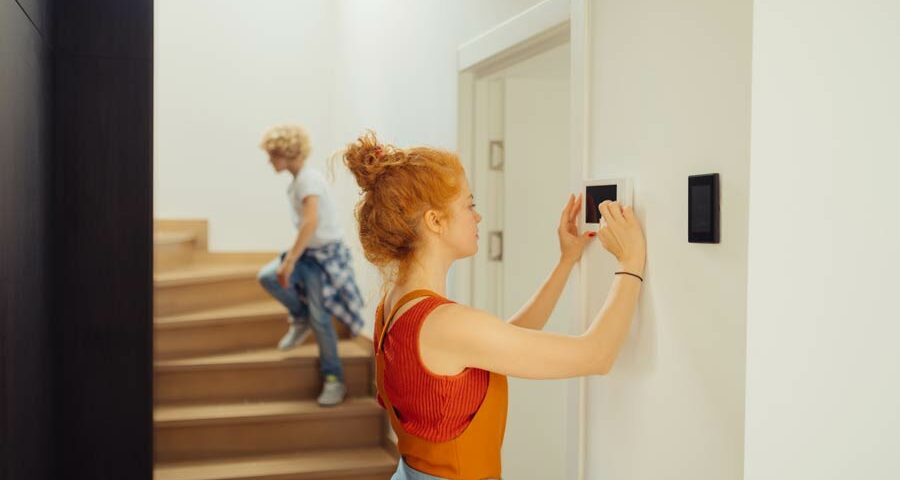You can save energy by correct heating and ventilation.
Set the right temperature for different room spaces
Dropping the room temperature by one degree can save 5% in heating costs. The easiest way to ensure the correct indoor temperature is to get a thermometer for the different rooms. The correct room temperature is 18–22°C depending on the room space. The recommended room temperatures in draught-free conditions:
- living spaces 20–22°C
- bedrooms 18–20°C
- store rooms 12°C
- garage 5°C
Away from home
If your home is going to be empty for several days, you can easily set the thermostats a few degrees lower. If your bathroom includes an electric comfort heating system, it pays off to turn it off for a longer absence. In any case, in hot weather, you should set your underfloor heating lower than the winter temperature. Make sure that all humid spaces are properly ventilated to let the floor dry during the day.
Underfloor heating in bathrooms
Make sure that you haven’t set the underfloor heating too high. If you are not using any other form of heating in a humid space, underfloor heating is required to prevent moisture damage. Approximately 24°C will usually do for a humid space.
In addition to your toes, you can feel the underfloor heating in your purse. Heating your bathrooms and other sanitary spaces can easily be the biggest consumer of energy in your home. Make sure that you haven’t set the underfloor heating too high. If you are not using any other form of heating in a humid space, underfloor heating is required to prevent moisture damage in the room. You should still set the temperature high enough. Approximately 24°C will usually do for a humid space.
Prepare for hot summer weather
Don’t let the hot air in and avoid using heat-generating equipment. If your home includes an automatic ventilation system, keep your doors and windows shut during daytime, cover the windows on the sunny side with curtains or blinds, turn off all unnecessary electrical equipment, avoid heating your oven or sauna, open windows on the shady side and use the cooler night air for ventilation.
In hot summer weather, a heat pump will cool the indoor air nicely. That said, a heat pump can consume a huge amount of energy, so use it in moderation. Remember to read Motiva’s handy cooling tips and take proactive action to prevent your home from overheating. This way, you can keep the indoor air of your home or summer cottage nice and cool and postpone the use of energy-greedy cooling equipment until a later date.
Automatic cooling may not be required at all if you manage to keep the midday heat out of your home and avoid using heat-generating equipment inside. Remember ventilation and proper settings. Check that the radiators in your living spaces are turned off or set at a low temperature.
- If your home includes an automatic ventilation system, keep your doors and windows shut during daytime.
- Cover the windows on the sunny side with curtains or blinds.
- Turn off unnecessary electrical equipment. Avoid heating your oven or indoor sauna.
- If necessary, open a window on the shady side. Take advantage of the cool night air for ventilation.
- Choose an energy-efficient AC device.
Windows
Seal your doors and windows
Check the sealing of your doors and windows because roughly a third of the heat in your home escapes through the windows. You will save energy, make your home feel less draughty and reduce the need for maintenance of your door and window structures.
Open the curtains to enjoy natural light
On those rare days the sun comes out on these northern shores, make the most of it. Open your curtains or blinds to let the spring light in and make the most of the sun’s free heating energy.
Quick ventilation reduces energy waste
Ventilating your home with fresh air is a good idea. But if you ventilate for too long in the winter, you will let out heat and increase your heating costs. If you have electric radiators, turn them off while ventilating. A good way is to cross-ventilate by keeping doors or windows open on opposite sides of your home. Just a moment is enough to freshen the air up without making the rooms too cold.
Fireplaces
Take advantage of the heat in your fireplace and save heating costs
As far as home comforts go, nothing quite compares to lighting a fire on a cold, dark autumn evening and curling up in front of your fireplace – and the more you do it, the more energy you save.
Car
An hour is enough to heat your car
Starting the engine of your car in cold winter weather without preheating it places a burden on the engine and the environment. A cold and frosty car is not safe to drive and it’s not much fun for the driver, either. Preheating your car is a smart move because it improves safety and comfort. You should not plug your car in for the whole night. If the temperature drops below -15°C, one hour will suffice.
Monitor your electricity consumption in Elenia Aina
In the free Elenia Aina service, you can track the effect of the tips on your electricity consumption. Elenia Aina shows your consumption on a monthly, weekly or even hourly basis, and you can set an alarm limit for your consumption. Sign up today!
